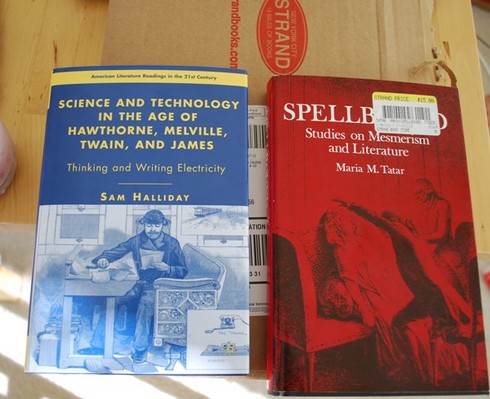January 28 Sam Halliday の Science and Technology in the Age of Hawthorne, Melville, Twain, and James (2007) とMaria Tatar の Spellbound (1978) [擬似科学周辺]
January 28, 2009 (Wednesday)
水曜日は小学校がふだんより2時間早く1時過ぎに終わるのだけれど、近所の人のクルマに乗せてもらったモーリちゃんを迎えに降りていったモーリちゃんの父がついさっき郵便ボックスで受け取った本2冊。
古いほう(右)から
☆Maria M. Tatar (1945 - ), Spellbound: Studies on Mesmerism and Literature. Princeton: Princeton University Press, 1978. xvi+293pp. $39.50をStrand Book Store で15ドルで購入
グリム童話の研究者として有名になったマリア・ターターの若い頃の著作。「スペルバウンド」はあっさり訳せば「呪縛」です。あるいは「とりこにされて」。スペルは「まじない」「呪文」「魔法」など超自然的な力と結びついたものを行使して相手を「束縛」「魅了」することです――歌で有名なのは "Screamin'" Jay Hawkins の "I Put a Spell on You"。ついさっきの記事でもこの本に触れたので、「魅力」の話のところを引き出そうと探したのですが見つからず、つい読みふけってしまいましたw。日本にペーパーバックと翻訳をもっているのですが、人に頼まれたので買いました(汚さぬように気をつけねば)。ただ章構成をメモっておきます――
1. From Mesmer to Freud: Animal Magnetism, Hypnosis, and Suggestion
2. Salvation by Electricity: Science, Poetry, and Naturphilosophie
3. Thunder, Lightning, and Electricity: Moments of Recognition in Heinrich von Kleist's Dramas
4. Blindness and Insight: Visionary Experience in the Tales of E. T. A. Hoffmann
5. The Metaphysics of the Will: Voyeurs and Visionaries in Balzac's Comédie humaine
6. Masters and Slaves: The Creative Process in Hawthorne's Fiction
7. From Science Fiction to Psychoanalysis: Henry James's Bostonians, D. H. Lawrence's Women in Love, and Thomas Mann's Mario and the Magician
Appendix: Mesmer's Propositions [1779年のMémoire sur la découverte du magnétisme animal にある27の命題(フランス語)]
☆Sam Halliday, Science and Technology in the Age of Hawthorne, Melville, Twain, and James: Thinking and Writing Electricity. New York: Palgrave Macmillan, 2007. xiii+245pp. $69.95を同じくStrand で34.97ドルで購入。
著者はロンドン大学の英文学と演劇の先生のようで。だからかどうか知りませんが、ホーソーン、メルヴィル、マーク・トウェイン、ヘンリー・ジェイムズという19世紀中葉から20世紀初頭のアメリカ作家をタイトルにあげながら、トマス・ハーディーやラディヤード・キプリングの話も出てくるのかしら。バックカヴァーにはマイケル・T・ギルモアが推薦文みたいなのを書いていて、"Halliday's bravura study" と呼び(ブラヴーラってもともとイタリア語で音楽関係で英語に入った言葉ですが、「勇壮華麗」「技巧誇示」みたいなのを特徴とする、「キラビヤカナ」「ハデハデシイ」といった意味です(英語のbravery と同語源のはずですが)。ギルモアは、とりあげられる人物の多彩さ(サミュエル・モースからヘレン・ケラーからホーソーン、マーク・トウェインからダニエル・パウル・シュレーバー)、そしてテクノロジーと文化の意外な結合(メスメリズムと奴隷制(まあよく聞くけど)、エーテルと表象、電信と陰謀など)を特徴としてあげ、 "Every page brings illumination; the book can aptly be called 'electifying.'" と電気的イメジをつらねています。副題の "Thinking and Writing Electricity" というのは電気自体が考えたり書いたりするという意味でしょうね。ぱらぱら見ているとジャック・デリダが出てきたりして、やっぱりむつかしそー。
もうひとりBarbara Will という先生も、一見異質なものの「テレパシー的telepathic」結合に目をみはっています――「ドラキュラと鉄道時刻表、人種と電信〔フォスターの「おおスザンナ」が出てくるかと思ったら出てこないみたいw〕、分離人格(多重人格)と電話交換」。「カルチュラル・スタディーズ 〔cultural studies 文化研究と訳すと田舎者と言われそうw〕のお手本となる本で、19~20世紀転換期のテクノロジーと文化について考えさせるだけでなく、広くコミュニケーション、個性、社会の意味について考えさせる」と書いています。
flap (カバー折り返し)の紹介――
This innovative book reveals the full extent of electricity's significance in nineteenth- and early-twentieth-century culture. Ranging across a vast array of materials, Halliday shows how electricity functioned as both a means of representing "other" things―from love and solidarity to embodiment and temporality―and as an object of representation in its own right. As well as Hawthorne, Melville, Twain, and James, the books considers other major American writers such as Whitman, Margaret Fuller, and Henry Adams; English writers such as Hardy and Kipling; and a galaxy of scientists and social commentators, including mesmerists, physicians, conspiracy thorists, psychologists, and theologians.
Introduction (Thinking and Writing Electricity/ Vitality, Sociality, and the Idea of Ideas/ The Sources of Electrical Thought: Science and Technology/ The Dialectic of Old and New; The Organization of the Book)
1. Time and Space (Introduction/ "Annihilating" Time and Space/ Railroads, Time, and the Logistical Sublime/ Intimacy, Love, and Simultaneity/ Powers of Mind/ Ghosts of Electricity/ Electro-Historicism: Henry Adams/ Powers of Tradition/ Coda: Inventing the "Medium")
2. Individual Difference and Self-Representation (Introduction/ "Training," Telegraphy, and Time/ "The Physiology and Psychology of the Telegraphic Language"/ Difference, Intersubjectivity, and Meaning/ Habits, Speed, and Automatism/ "Training," and the Medium/ "Resembling Oneself," and Portrait Painting/ "In-One-Another" and "After-Each-Other": Bodies and Machines/ Misrepresentation and the Voice/ Distance, Sound, and Sense)
3. Sympathy and Reciprocity (Introduction/ God, Reciprocity, and the Spirit of Music/ Mediums, Mesmerists, and "Sympathy"/ From "Sympathy" to Slavery/ Mesmerism and/as Slavery/ Illness, Intuition, and the Electricity of Young Girls/ Ether versus Flesh/ Coda: God's Body, and the Ultimate Life)
4. Connection and Division (Introduction/ The Nineteenth-Century Nervous System (1)/ Sex, Disease, and "Civilization"/ Polarity, Perversity, and "Father-Stuff"/ The Nineteenth-Century Nervous System (2)/ Coda: Connection through Division)
5. Inclusion and Exclusion (Introduction/ Phenomenology of Secrets/ Publicity, "Detection," and Adultery: Telegraphy in Henry James/ "Underground" or "Mute" Telegraphy, and "Race"/ The End, and the Coming of a "Crisis in God's Realms"
あー、行か写経のように書き写していたら全部読んだ気になりました(w)。本文は195ページまでで注が40ページにわたってついています。やれやれ。カッコつきの語の多さはディコンストラクション的脱比喩のなごりでしょうか。
ともあれ、電気を中心に扱った本書にはジョン・ボヴィー・ドッズもガルヴァニもメスマーも登場するだけでなく、多重人格のモートン・プリンスや心理分析のフロイト、あるいはメスメリズムはもちろん、ファウラー兄弟、フリーメーソン、骨相学、観相術、心霊研究協会やスピリチュアリズムに超常現象など、擬似科学的・オカルト的な話題も満載のようでございます。
そういえばデリダが晩年スピリットについてなんか書いていたのを日本で読みかけてやめてしまったけれど、ディコンストラクションで身体・精神の二分法を突破できるのだろうか。レトリックで突破してもしょうがないしなあ。
あ、買った本を記録しようと思いつつどんどんたまるいっぽうで、どうしようと思っていたのですが、こういうかたちで放り込んでみます。
Strand Book Store はニューヨークで1927年に創業されて現在本店がブロードウェイにある有名な古本屋さんですが、今はWEB でも商売をしており、古本屋さんらしく、まとめて注文すると2冊目からは送料を安くしてくれるのでよいです。ニューヨークの店に入ったのはもう10年以上前ですけれど、同じ本が何冊も並んでいて呆れました。送料は2冊で4ドル。21日注文。
----------------------------------------------
Strand Bookstore: Home of 18 miles of New, Used, Rare and Out of Print Books <http://www.strandbooks.com/>






コメント 0